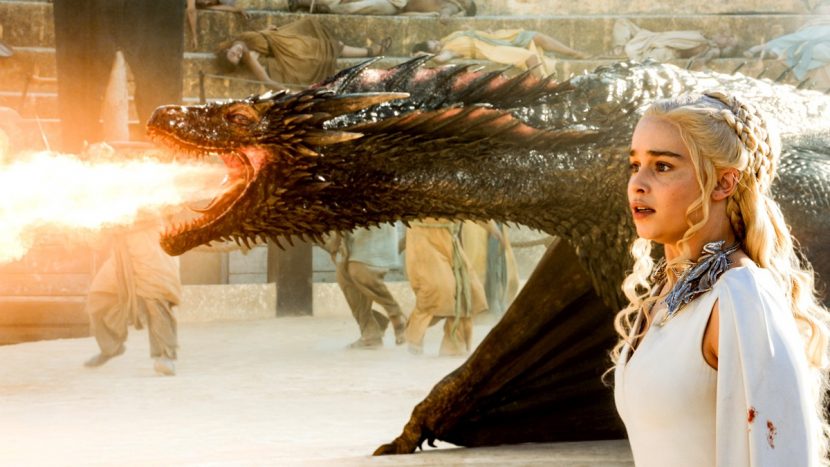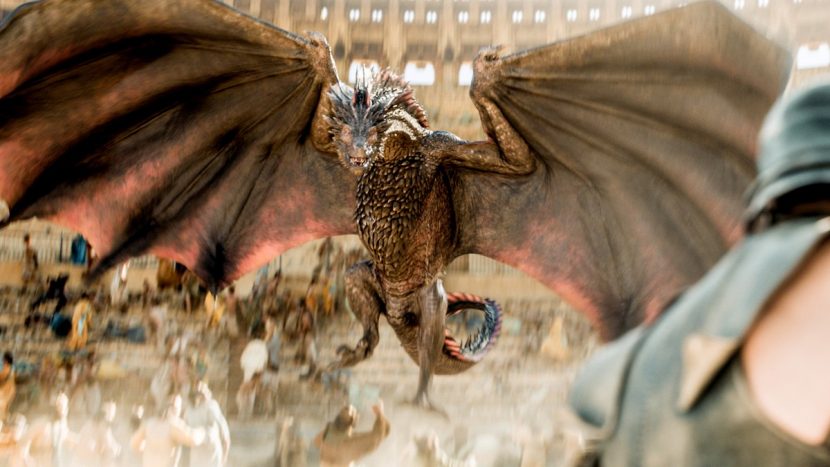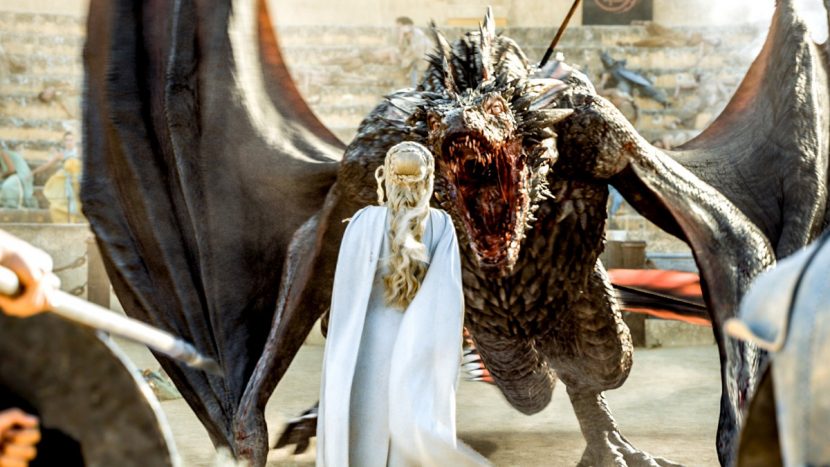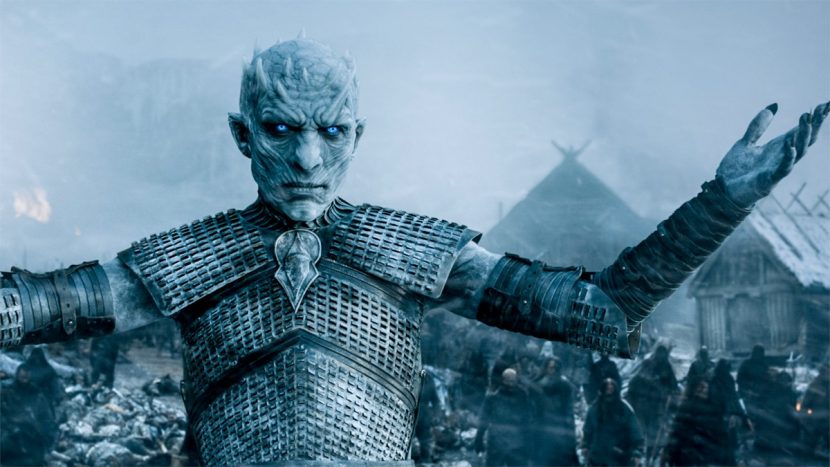During this past season of HBO’s Game of Thrones, two brutal sequences had a lasting impact on audiences. The first was the devastating wildlings and wights battle at Hardhome from episode 8, and the second revolved around the Daznak’s Pit fight and Drogon’s appearance in episode 9. Both were key moments for the main characters, and both required significant collaborations between the show’s art department, camera, stunt, special effects, make-up, prosthetics and visual effects teams. fxguide speaks to visual effects supervisor Joe Bauer and visual effects producer Steve Kullback about how these sequences were made, starting with episode 9.
Above: watch our breakdown of the Daznak’s Pit sequence, thanks to our media partners at WIRED.
The Dance of Dragons – how Drogon saves the day
After being reluctantly convinced that the fighting season should be re-started in Meereen, Daenerys (Emilia Clarke) and her entourage watch a spate of battles in Daznak’s Pit. Soon however, it is revealed that the Sons of the Harpy are intent on killing Daenerys. She and her protectors only manage to escape to the center of the fighting ring, when suddenly a fire-breathing Drogon arrives. Although Drogon burns many of the Sons alive, they fight back with spears until Daenerys climbs onto the dragon’s back and flies away.
In the arena
Planning both an arena fight and a dragon appearance involved significant co-ordination once again amongst the Game of Thrones production team to create shots that would incorporate live action, 500 extras (an extraordinary 68,000 people made an application to be one of these extras), set extensions, digital crowds, real fire and a CG Drogon. Extensive storyboards and then previs from The Third Floor, lead by previsualization supervisor Eric Carney, helped director David Nutter block out the sequence. During the shoot previs also fed a simul-cam to aide shooting. Rhythm & Hues handled the final visual effects.
Above: watch Rhythm & Hues’ video showcasing how they made the fire breathing Drogon.
Principal photography took place in Osuna, Spain, at the Plaza de Toros – a real bull ring. “The location is one tier high and the final Daznak is three tiers,” notes Bauer. “The set was really great – it was a 360 degree set that the art department could really get its teeth into and transform into the bottom tier of the Daznak. At one point we had a 200 foot greenscreen that was 30 feet high around an arc of the top of the bull ring that we could shoot into. Because inevitably when you’re shooting these fights, you can pretty quickly get off the top of that one tier shooting into the sky. But we had some incredibly high winds which wiped out our greenscreen after only a couple of days of shooting. Then we were at the mercy of the super blue Spanish sky, which actually worked out well and we were able to pull keys off that.”
The method for filling the stadium with action was aided from the original planning and design stages. “We’d previs’d the whole thing using the three tier model of the arena,” says Bauer, “which was designed partially by the art department and partially by the concept lead Tobias Mannewitz from Karakter. He did a re-design of the Roman Colosseum and improved on it! Those big sails – the mechanisms he came up with actually worked. We moved our cameras around that and worked out how high above the bull ring we need a vantage point. It ended up being 150 foot construction crane which had to be positioned per planning. It shot from a locked position and from there we also shot a number of tiles of 500 extras who were physically in the ring and moved in position around the perimeter.”
Rhythm & Hues had successfully filled baseball stadiums using a similar method for Moneyball (read fxguide’s coverage here). “With the same photographed extras,” explains Bauer, “they could re-light for a number of different lighting situations. We shot in the bull ring for ten days from sun up to sun down and pointing all directions. Shot by shot, the lighting situation was different – so shooting one lighting situation for the crowd extensions wouldn’t have really worked. Rhythm advised us to set up a bluescreen installation and then we brought in one or two extras at a time and shot them going through a menu of physical reactions moving and cheering, standing, fist-pumping. Then that got us through all of the crowd extension, until the attack begins, and then everyone starts running around at which point we had to go with full digital doubles.”
In the final shots, generally the lower tier included real extras, with digi-doubles making up the higher tiers. Digi-doubles were also used to add in extra numbers of Sons entering the arena and flooding the ring. “There weren’t as many as desired after shooting,” notes Kullback. “So we then added 50 to 100 CG Harpies coming in animated by R&H from mocap and keyframe work, using all of the scanned material of the extras and scans of the costumes.”
Enter the Drogon
Drogon arrives and quickly causes mayhem in the Daznak pit. For shots of him on the ground, Bauer’s visual effects team made use of a green pole for eyelines, as well as a practical Drogon head. “Later when we got to the fire breathing stuff,” recounts Bauer, “we had a simul-cam set-up which was supplied by The Third Floor. We had pre-animated the dragon for those shots, so on a monitor we could plug in the animation of the dragon and our operators could see that and account for the framing. Other than that it was a careful process of measuring a no-go space for the extras and a hole for the height of Drogon’s head.” The Third Floor’s head of virtual production, Casey Schatz, ran the simul-cam.
Rhythm & Hues’s team (led by CG supervisor Derek Spears) utilized Pixomondo and Dan Katcher’s dragon model and textures for the sequence, a scene in which Drogon had to be combatant, angry and emotional. “For Drogon’s apperances,” states Bauer, “my directions were ‘sports car’ when he comes in and lands as he comes to save day. In the shaking he’s a ‘great white shark’, and the fire breathing didn’t need much direction since they had that very much in hand in terms of moving the weight and muscle. Encountering Dany, he’s really in a berserka rage and forced into a corner fighting for his life – they wage war back and he’s actually losing as Dany’s approaching him and then takes off. So he’s just in attack mode and his brain has to clear to work out who Dany is. It’s really a King Kong moment – he sees through the bloody eyes and nose the connection they have.”
Drogon makes short work of his initial attackers, sometimes by grabbing them in his jaws. Stunt co-ordinator Rowley Irlam’s team made these shots possible with live action gags involving machines with lifts and wire rigs and pulleys. “The stunt performer would run forward,” describes Bauer, “he hits a point at the end of his wire and gets yanked back. They’re able to get the coverage up to the point where the guy is fully in Drogon’s jaws, and then it’s a digi-double after that.”
The dragon also deploys devastating force via his fire-breathing skills, causing several Sons to burn alive. That effect was staged practically in the bull ring. “We knew that if the fire was at all fake,” notes Bauer, “the whole sequence falls apart. To start we opted to pre-animate the dragon. We plotted out exactly where he would operate within the arena. Then we made it a motion control gag. We not only pre-animated the dragon but also the camera shooting him. Then we had a flame thrower from Stuart Brisdon’s team that would shoot 50 feet on one motion control crane, and we had the hero camera on the other motion control crane, and then played back what we had previs’d, using digital versions of those cranes.”
Rowley Irlam’s stunt team then co-ordinated live burns on Sons performers. “We worked out specific burns so we could mark it all out in the arena,” says Bauer. “Cued by the computer, the fire would start at a certain point, hit a certain spot, pan a certain distance and then shut off. For safety, special effects had a kill switch, so they could kill the fire stream at any point. They are photographed burns, and the flame thrower actually did ignite the people being burned.”
Daenerys’ climb onto Drogon’s back made use of a special buck fitted on a parallelogram rig for that purpose. “Based on the dragon model that was in process,” says Kullback, “we had derived a variety of slices from the back where Emilia would be in contact. Our special effects team led by Stuart Brisdon built the buck. The buck was controlled both hydraulically and manually to match into the animation that was pre-animated by R&H. We were very keen on shooting this in the actual light that the scene was being shot in, so we shipped our buck to Spain and shot it in the bull ring with a variety of greenscreens so that we could have the buck on the move, so that the lighting would fold around Emilia as she’s circling on her departure. It was manually operated with greenscreens being organized to travel with it by our visual effects key grip Paul Hatchman.”
Hardhome – wildlings vs wights
After traveling to the Wildling village of Hardhome, Jon Snow (Kit Harington) and a band of men from the Night’s Watch convince around 5,000 wildlings to return with them. But during the ship loading, Hardhome is attacked by a massive army of wights. A brutal battle ensues, overseen by several White Walkers. When they also enter the fray, Jon Snow engages in a one-on-one fight, his Valyrian steel sword killing one of the Walkers. The survivors manage to escape Hardhome but only to witness the Night’s King reviving the deceased wildlings as wights.
Building a village
The sheer size and scale of the Hardhome battle required some major planning – that came in the form of meticulous storyboards, and then previs by The Third Floor, in consultation with director Miguel Sapochnik. Most of the sequence’s final visual effects – environments, crowds, wight augmentation and digital wildlings – would be created by El Ranchito.
To aid in previs’ing the location, LIDAR scans and an aerial scan were used to map out environments. “We also had a set plan from the art department for what would be a very extensive build,” says Bauer. “They built the whole village, including the long hall. The exterior was a hollow set that would burn and we could bash through when Wun Wun comes out, and then there was a separate interior set built which also had to burn.”
This planning step provided an accurate layout of the environment in which to block out coverage. “Miguel would describe the keyframes,” adds Bauer, “and he would refer to the storyboards and then the animators would just run with the camera moves. When we were done we could cut the whole sequence together with sound and music. If you watch the previs and watch the finished the sequence, it’s very nearly shot for shot.”
Physical production took place in Northern Ireland during the months of November and December. “The weather was horrible,” notes Bauer, “but that was a big asset to us, even though it was dreadful to shoot in with the high winds and pelting rain and the mud.”
The final environment also included extensions that incorporated a beach in Iceland (actually a location that had initially been considered for shooting at, but would have involved short filming days and even more unpredictable weather). “We still used the location,” outlines Bauer, “by taking a LIDAR scan of that beach and combining it together with the LIDAR scan of the Northern Ireland location. We were able to extend it with two real locations. So what you see off in the distance is Iceland – re-sized a little bit. The area that the wildlings are camped in beyond the stockade fence is four or five times bigger than the Iceland beach – it had to hold 100,000 wildlings. Fortunately there was a huge storm when the plate crew was shooting and they captured that. The waves smashing against the rocks was all photography, which we sat into our 3D project.”
On the Northern Ireland set, the production made use of a 15 foot high and 150 foot long greenscreen outside the stockage fence, which was shot into from a couple of different angles. Says Bauer: “We shot the in-camera wildling extras in front of that, and then we also shot separate tiles of them. It was a lot of tile photography laid out into our 3D project, and then we handed off to digi-doubles after that. We also photographed camp fire tiles, and stuff we had from the Mance Rayder camp in season 3.”
Wrangling wights
The battle begins as scores of wights look to climb, or even push through, the stockade fence. Four different types of wights made up the sequence, as Bauer describes below:
1. Freshly dead – “These were make-up-based, non prosthetic wights with fresh wounds and blood, co-ordinated by makeup designer Jane Walker.”
2. Prosthetic wights – “These were handled by prosthetics supervisor Barrie Gower. They had a prosthetic treatment which was more elaborate for close-ups, with masks for the wights that weren’t as close to camera.”
3. Prosthetics with greenscreen – “This third category were prosthetic wights with greenscreen areas, where we would poke holes and reveal negative space. So there’d be say half a head, or a missing arm or a green blob in the waist or torso.”
4. Green suits – “These wights were performers in green suits with perhaps some costume and some rubber bone, and we’d replace the green or sometimes replace the wight entirely with a digital version.”
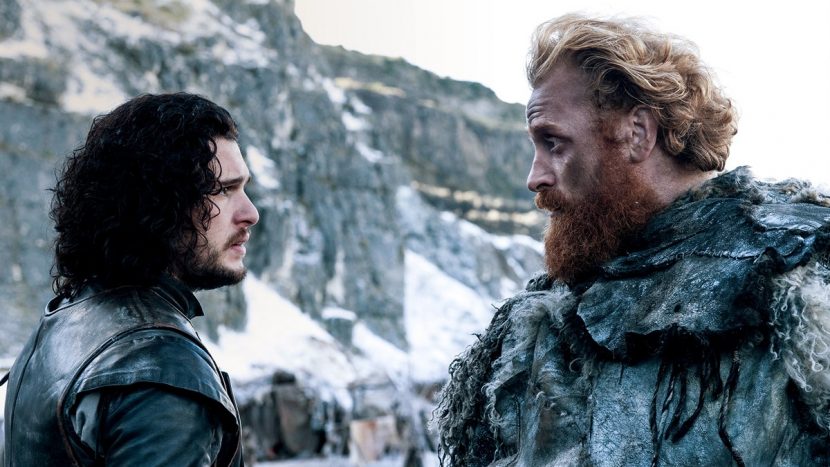 In each case, production had the wight performers (as well as White Walker performers for later scenes) scanned and photographed for reference so that the visual effects team could re-create body parts or digital characters entirely. “We did photogrammetry scanning of virtually all of the hero characters and looks for both with and without their prosthetic make-up on,” explains Kullback. “Clear Angle Studios did the scanning – they set up a tent very close to the set and we were able to move over a 100 people a day through it. We also do an enormous amount of texture photography and cyberscanning as needed, such as props and costume pieces. All of that was beautifully wrangled by our visual effects associate producer Adam Chazen who is the king of all we survey.”
In each case, production had the wight performers (as well as White Walker performers for later scenes) scanned and photographed for reference so that the visual effects team could re-create body parts or digital characters entirely. “We did photogrammetry scanning of virtually all of the hero characters and looks for both with and without their prosthetic make-up on,” explains Kullback. “Clear Angle Studios did the scanning – they set up a tent very close to the set and we were able to move over a 100 people a day through it. We also do an enormous amount of texture photography and cyberscanning as needed, such as props and costume pieces. All of that was beautifully wrangled by our visual effects associate producer Adam Chazen who is the king of all we survey.”
Although some enhancements were made, such as to the White Walker eyes to make them glow blue, much of the prosthetic work remained untouched by visual effects. “That’s a huge credit to Barrie and his team,” acknowledges Bauer. “The only times that we would have replaced the prosthetic was on a full greenscreen wight – even then most of the time we used the costume that was on the green suit.”
The wrath of Wun Wun
Hardhome wildling giant Wun Wun (Ian Whyte) proves his worth against the attacking wights by stomping, throwing and beating off many of the attackers. Having worked on scale shots in previous seasons of the show, the visual effects team followed similar methods to stage scenes of Wun Wun amongst human-sized characters, but these still had to be carefully planned.
The first step involved working with the art department to re-create in half scale the ground plane that Ian Whyte would be performing on. “Because it’s a long run at Hardhome from him exiting the long hall to getting down to the shore line and into the water,” relates Bauer, “we had a few different ground planes for him to perform on. The art department took very special care to accurately duplicate what they had made at full scale on the set.”
“Our DOP, Fabian Wagner, also duplicated on a greenscreen stage the lighting situation for each of those pieces that we had shot on location,” adds Bauer. “When the lighting is right, the practical set is right, including the long hall which was shot over a couple of days on set to get the practical full scale explosion done by special effects supervisor Stuart Brisdon and his team. And then we would re-create that on the greenscreen stage in miniature, in part, so that Ian would have something physical to push through.”
The wights jumping on Wun Wun were fully CG, but to give the digital effects team some reference, a special thirteen foot buck was built. “We called it the Christmas tree,” says Bauer. “It was a cone that had a cargo net over it. It was omni-directional – it could be moved by pulling ropes. The stunt team would pull these ropes twisting and turning it around like an American Gladiator challenge. We had five stunt guys in trackable gray suits and a number of cameras on them. As they would run and jump and climb and swing around and fall off onto pads, we had that covered by multiple angles. We lined up each stunt guy’s performance – we put their camera view side by side and then we could say we want this part of this wight’s performance to be like this, and a different piece where he swings or falls off.”
An avalanche of bodies
The White Walkers waste no time in sending even more wights into the fold, commanding them to hurl over the cliffs above Hardhome as Jon Snow and Eddison Tollett (Ben Crompton) look on.
El Ranchito worked on crowd and rag-doll simulations for the shots, which, like much of the sequence, still made use of original photography. “For the first view when the camera is running with the wights and approaching and going over the cliff,” explains Bauer, “we previs’d that and realized what we needed size-wise. We built a ramp that was dressed to look like the top of the cliff. It was almost 60 foot square and five feet on the raised side, with stunt pads below that – facing a big greenscreen.”
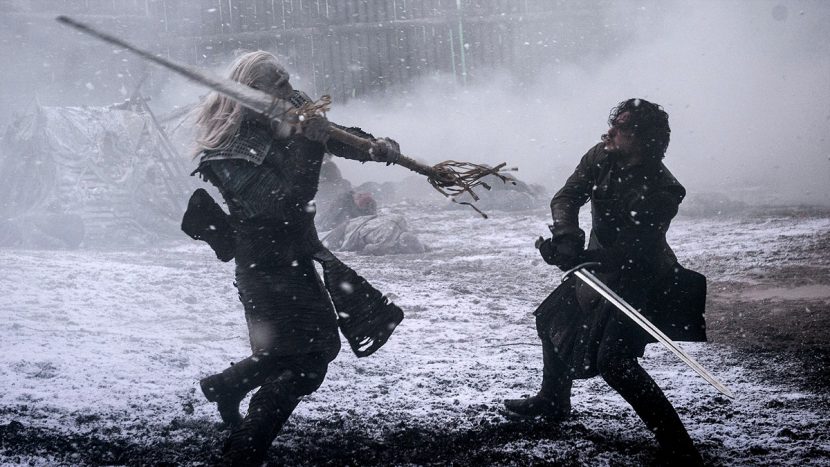 The stunt performers were then filmed with a camera crane – a MovieBird – extending out so the camera would be traveling with them. “Then,” says Bauer, “the performers would go to a point over the edge and fall and hit the stunt pad and roll off. We did a couple of takes of that. Then we also had photography that producer Chris Newman shot from the top of the actual cliff looking down onto the set. So beyond that it was a big digital set extension combining all these camera moves. Then we did lots of on-camera hand-offs from the photographed stunt people to their digital counterparts. So we ran with them all the way to the edge, they throw themselves over and if you watch one you can see them fall all the way to ground and hit. The ‘Ranchitos’, as we call them, had a great crowd sim with great sim dynamics in place. They showed us early on John and Edd’s view of the avalanche and just the way the bodies hit and bounce against each other.”
The stunt performers were then filmed with a camera crane – a MovieBird – extending out so the camera would be traveling with them. “Then,” says Bauer, “the performers would go to a point over the edge and fall and hit the stunt pad and roll off. We did a couple of takes of that. Then we also had photography that producer Chris Newman shot from the top of the actual cliff looking down onto the set. So beyond that it was a big digital set extension combining all these camera moves. Then we did lots of on-camera hand-offs from the photographed stunt people to their digital counterparts. So we ran with them all the way to the edge, they throw themselves over and if you watch one you can see them fall all the way to ground and hit. The ‘Ranchitos’, as we call them, had a great crowd sim with great sim dynamics in place. They showed us early on John and Edd’s view of the avalanche and just the way the bodies hit and bounce against each other.”
Bauer adds that a significant portion of those shots, and others in the battle scenes, featured views of the armada of ships in the distance. “It’s perhaps not so hard to add digital mountains and cliffs,” he says, “but it’s a whole extra thing to extend a lake into an ocean, and an ocean that has a huge storm going on and tossing huge boats around. We never get close to those boats – they’re just a backdrop but dynamically it’s all correct. That’s a combination of the storm plates shot in Iceland, CG water, a library of people in skiffs that we shot in a large greenscreen tank rowing to and from which had to be placed, CG skiffs too, plus CG sailboats with cloth-sim’d sails, and all the weather. It’s never your focus of attention, but it really helps tell the story and add scope to the scene.”
Always snowing
Another almost invisible effect seen in the Hardhome confrontation is the presence of snow and atmosphere. “The vast majority of that was augmented,” says Kullback, “but was still based on the live action snow that was shot with our special effects team and Stuart Brisdon’s work. Everything we set out to do weather-wise was intended to at least start in camera. So there was an immense effort on their part to have blowing snow and to have a progression of the weather event. But with the craziness of the actual weather in Belfast was something that required us to do it in post.”
The snow was handled by a small satellite team which began by charting the progression of the weather. “As the skiffs are starting to come ashore,” states Kullback, “it’s a very light flurry. As they start approaching the gate it starts to amp up, and as the shit is hitting the fan, it all became rather chaotic, in keeping with the direction of the story which was heavily designed by our director Miguel. Sometimes that was helped out by the real weather – there were some points where it really seemed as though we had to stop shooting but the decision was made let’s keep going and run with it – it was factored into the intensity of the sequence.”
Of course, these two sequences from ‘Hardhome’ and ‘The Dance of Dragons’ represent just some of the elaborate visual effects work from season 5 of Game of Thrones. The final shot count for the series came in at close to 1800 shots, many of which made heavy use, too, of as much practical photography as is possible in bringing the world of Westeros to life. “It’s always important to have an anchor in real photography when you’re doing CG or else you drift off into ‘fakey’ no-man’s-land,” suggests Bauer. “We do that with our environments, set extensions and make-up. The only thing we can’t really do it with is the dragon, but even then we look at real-world reference.”
All images and clips copyright 2015 HBO.

